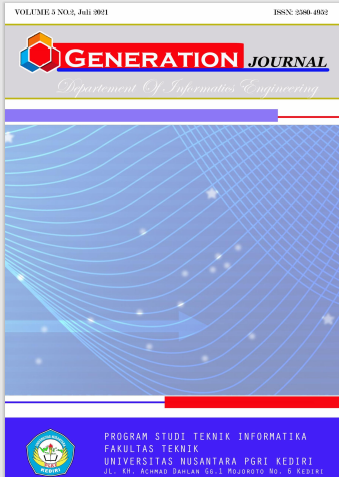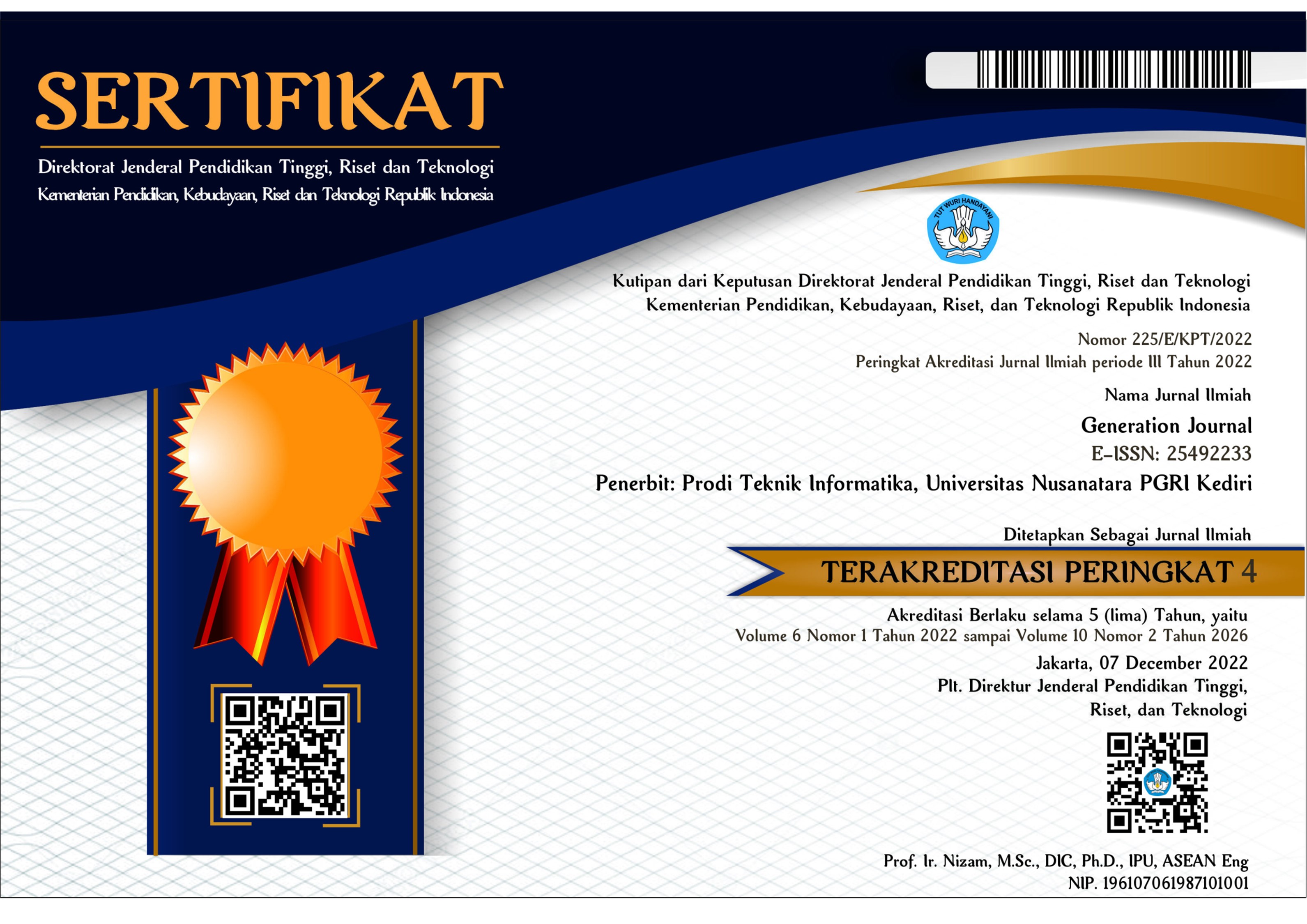Metode Fuzzy Mamdani Pada Sistem Pendukung Keputusan Penentuan Jumlah Petugas BPBD Takengon
DOI:
https://doi.org/10.29407/gj.v5i2.15638Keywords:
Fuzzy Mamdani Method, Natural Disaster, DSS, MatlabAbstract
To determine the number of officers at the Regional Disaster Management
Agency (BPBD), the results of the Fuzzy calculations 2020. In May there are 70 requests for officers,
while the number of existing officers is 109 and possibly 95. In June the requests for officers are 80,
while the existing officers are 90 and possibly 87. In July the requests for officers are 90 , while the
existing officers numbered 75 and possibly 72 were assigned. Until September the request for
officers was 40, the existing officers were 58 and possibly 41 were assigned. Tests were also carried
out using matlab tools as a form of implementation in order to get accurate results according to
with manual calculation of the Fuzzy mamdani method.
References
[2] Alamsyah and T. Handayani, “Pengaruh Sumber Daya Organisasi Terhadap Kesiapsiagaan Petugas Bpbd Kabupaten Jeneponto Dalam Menghadapi Bencana,” Heal. Papua, vol. 3, no. 1, pp. 121–126, 2020.
[3] S. Prayesti, A. I. Hadiana, and F. R. Umbara, “Sistem Informasi Manajemen Penanggulangan Bencana Alam di Kabupaten Bandung Barat,” Inform. Digit. Expert, vol. 2, no. 1, pp. 19–22, 2020.
[4] B. Satria, “Implementation Of Additive Ratio Assessment (ARAS) Method On Decision Support System For Recipient Of Inhabitable House,” JITK (Jurnal Ilmu Pengetah. Dan Teknol. Komputer), vol. 6, no. 1, pp. 121–128, 2020.
[5] I. Nur Okta and B. Satria, “Sistem Pendukung Keputusan Dalam Menentukan Perbaikan Jalan Rusak Dengan Menggunakan Metode Simple Additive Weighting (SAW) (Studi Kasus : Kabupaten Kuantan Singingi),” Jar. Sist. Inf. Robot., vol. 3, no. 1, pp. 194–202, 2019.
[6] B. Satria and L. Tambunan, “Sistem Pendukung Keputusan Penerima Bantuan Rumah Layak Huni Menggunakan FMADM dan SAW,” JOINTECS (Journal Inf. Technol. Comput. Sci., vol. 5, no. 3, pp. 167–176, 2020.
[7] F. Y. Febriliana and M. T. Jatipaningrum, “SISTEM INFERENSI FUZZY MAMDANI DAN TSUKAMOTO DALAM SISTEM PENDUKUNG KEPUTUSAN UNTUK MENENTUKAN VOLUME IMPOR MINYAK BUMI DI INDONESIA,” J. Stat. Ind. dan Komputasi, vol. 5, no. 1, pp. 11–21, 2020.
[8] A. Ikhwan, L. Turrubiah Hsb, A. Windi Pratiwi, and A. Raynaldi, “Penerapan Fuzzy Mamdani Untuk Sistem Pendukung Keputusan Pemilihan Laptop,” J. Fasilkom, vol. 9, no. 2, pp. 476–483, 2019.
[9] Masparudin, Abdullah, and Usman, “Sistem Prediksi Kualitas Santan Kelapa Menggunakan Nearest Mean Classifier (NMC),” Sist. J. Sist. Inf., vol. 9, no. 3, pp. 646–655, 2020.
[10] D. L. Rahakbauw, F. J. Rianekuay, and Y. A. Lesnussa, “Penerapan Metode Fuzzy Mamdani Untuk Memprediksi Jumlah Produksi Karet (Studi Kasus: Data Persediaan Dan Permintaan Produksi Karet Pada Ptp Nusantara XIV (Persero) Kebun Awaya, Teluk Elpaputih, Maluku-Indonesia),” J. Ilm. Mat. Dan Terap., vol. 16, no. 1, pp. 119–127, 2019.
[11] B. Satria, “Prediksi Volume Penggunaan Air PDAM Menggunakan Metode Jaringan Syaraf Tiruan Backpropagation,” J. RESTI (Rekayasa Sist. dan Teknol. Informasi), vol. 2, no. 3, pp. 674–684, 2018.
[12] C. T. Utari, “Prediksi Jumlah Actual Stock pada Produksi Sarung Tangan Menggunakan Metode Fuzzy Mamdani,” Riau J. Comput. Sci., vol. 06, no. 01, pp. 59–70, 2020.
[13] P. Harianto and R. Wardoyo, “Sistem Pendukung Keputusan Penentuan Atlet Berbakat Menggunakan Metode Fuzzy Mamdani,” Berk. MIPA, vol. 25, no. 3, pp. 233–241, 2018.
[14] M. Dandi and T. Hidayat, “Analaisis Prediksi Problem Virtual Machine Server Menggunakan Metode Fuzzy Logic,” TEKNOKOM, vol. 3, no. 1, pp. 1–6, 2020.
[15] F. Harkeniza, “IDENTIFIKASI BESARAN PAJAK TANAH MENGGUNAKAN FUZZY MAMDANI ( STUDI KASUS DI BAPENDA PEKANBARU ),” J. IndraTech, vol. 1, no. 1, pp. 53–64, 2020.
[16] D. Tauhida, “APLIKASI FUZZY MAMDANI DALAM PEMILIHAN NOTEBOOK BERDASARKAN PRICE, SPECIFICATION DAN BEAUTY,” Pros. SNATIF ke-6 Tahun 2019, pp. 197–206, 2019.
[17] R. A. Krisdiawan, M. F. Rohmana, and A. Permana, “Pembuatan Game Runaway From Culik Dengan Algoritma Fuzzy Mamdani,” Buffer Inform., vol. 6, no. 1, pp. 33–40, 2020.
[18] H. Suprapto and P. Simanjuntak, “FUZZY LOGIC UNTUK MEMPREDIKSI PEMAKAIAN LISTRIK MENGGUNAKAN METODE MAMDANI,” Comasie, vol. 03, no. 02, pp. 31–39, 2020.
[19] S. Nurhayati and I. Immanudin, “Penerapan Logika Fuzzy Mamdani Untuk Prediksi Pengadaan Peralatan Rumah Tangga Rumah Sakit,” Komputika J. Sist. Komput., vol. 8, no. 2, pp. 81–87, 2019.
[20] A. Muthohar and Y. Rahayu, “Implementasi Logika Fuzzy Mamdani Pada Penilaian Kinerja Pelayanan Perawat,” J. Appl. Intell. Syst., vol. 1, no. 1, pp. 67–76, 2016.
Downloads
Published
Issue
Section
License
Authors who publish with this journal agree to the following terms:
- Copyright on any article is retained by the author(s).
- The author grants the journal, the right of first publication with the work simultaneously licensed under a Creative Commons Attribution License that allows others to share the work with an acknowledgment of the work’s authorship and initial publication in this journal.
- Authors are able to enter into separate, additional contractual arrangements for the non-exclusive distribution of the journal’s published version of the work (e.g., post it to an institutional repository or publish it in a book), with an acknowledgment of its initial publication in this journal.
- Authors are permitted and encouraged to post their work online (e.g., in institutional repositories or on their website) prior to and during the submission process, as it can lead to productive exchanges, as well as earlier and greater citation of published work.
- The article and any associated published material is distributed under the Creative Commons Attribution-ShareAlike 4.0 International License














